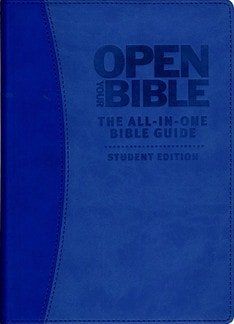Open your Bible: the all-in-one Bible guide
Martin Manser (Ed.)
Creative 4 International, 848 pages, £28.49
ISBN: 978-0-7554-8991-6
Big, well produced and colourful, this book grabs the attention. It ambitiously sets out to be a comprehensive, one-volume overview of Christian faith, practice and the Bible. A mammoth task for just one volume, the approach focuses on breadth rather than depth.
The book is aimed at younger people or those new to the faith. Popular appeal and accessibility characterise this tome throughout. Reflected by the price, the 800-plus pages are glossy and use varied fonts and colours to help maintain interest.
Scores of photographs intersperse the text, from mood-setting images of sunsets and lighthouses, to snaps of smiling Christian communities in developing world countries. Maps, charts and illustrations also appear regularly.
In terms of textual content, the book is a mosaic of much smaller sections and subsections. The first 99 pages are on ‘Knowing Jesus’, sketching his identity, life and teaching.
The next 289 pages overview the Bible itself, book by book. 133 pages on ‘Bible teaching’ follow, broad brush strokes covering salvation, humanity, the church, last things and other bread-and-butter topics.
‘Discovering God’s way’ comes next, 131 pages exploring prayer and discipleship. The final significant division is ‘Living the Christian life’, comprising 115 pages on key verbs for the Christian to cultivate (‘knowing’, ‘growing’, ‘belonging’, amidst others).
More a reference book, Open your Bible is very easy to dip into. Self-contained sections are only ever a few pages long and the writing is readable and digestible. Frequent, interactive elements such as questions and sections entitled ‘To think about’ encourage thought and exposition while reading. These are a plus and make the book useful for small group study.
The tenor of the teaching struck me as Protestant, but non-denominational. Indeed, the book’s major shortcoming is avoidance of clarity on divisive or contentious issues.
In terms of young earth creationism, women ministers, eternal punishment and Calvinism, the book hedges its bets. This struck me as unfortunate, as these are the very areas most in need of defence rather than demur in this liberal age.
Having said that, there is much in the book that is well written, doctrinally sound and good for practical application. This is perhaps an inevitable result of the differing stances of the 20 or so contributors.
With additional material clarifying, if not correcting, positions taken in this book, I would recommend it. Exercise caution and discernment if buying.
John Tredgett
Carlisle





